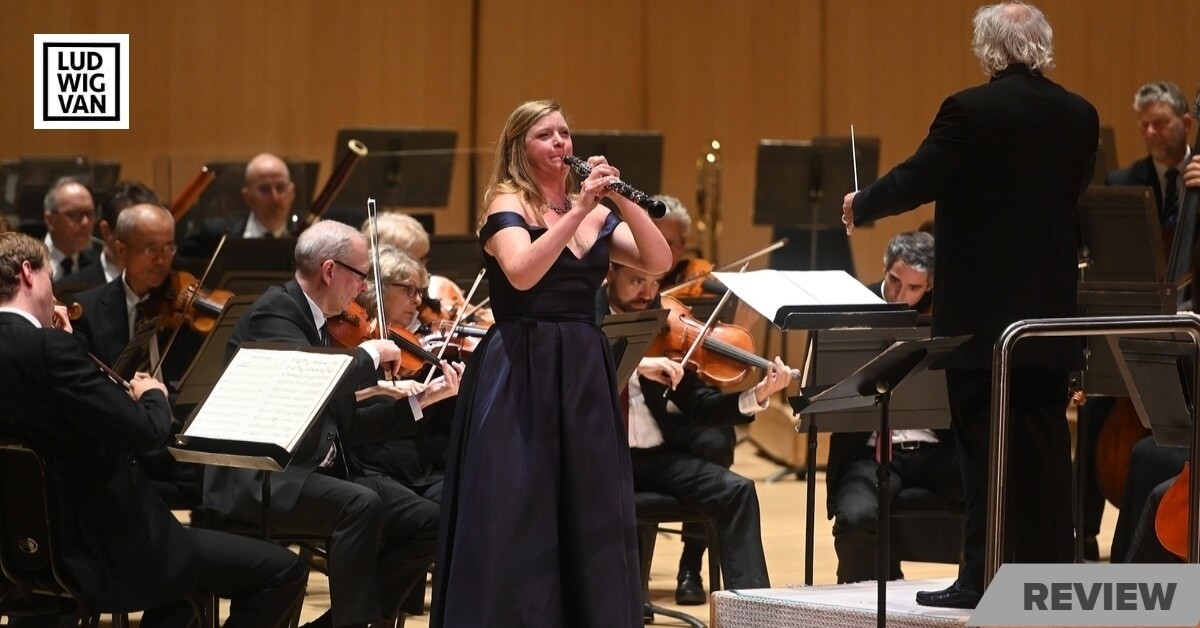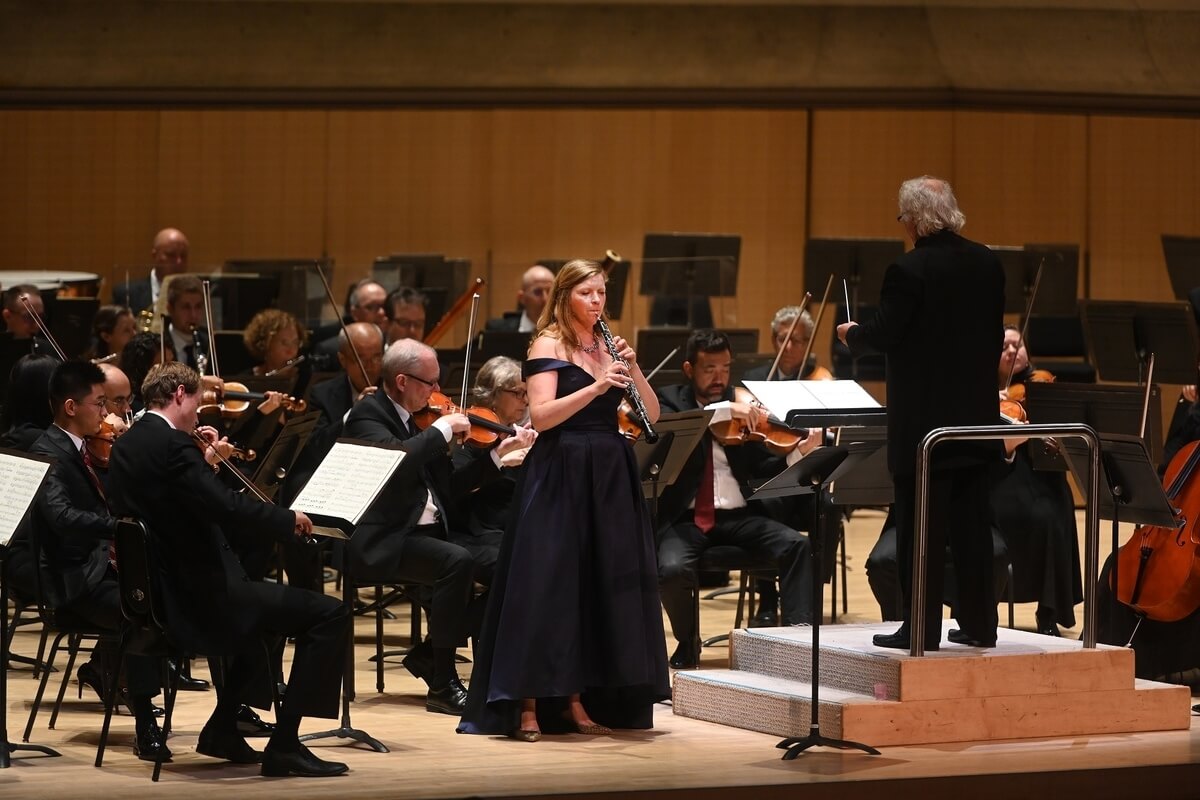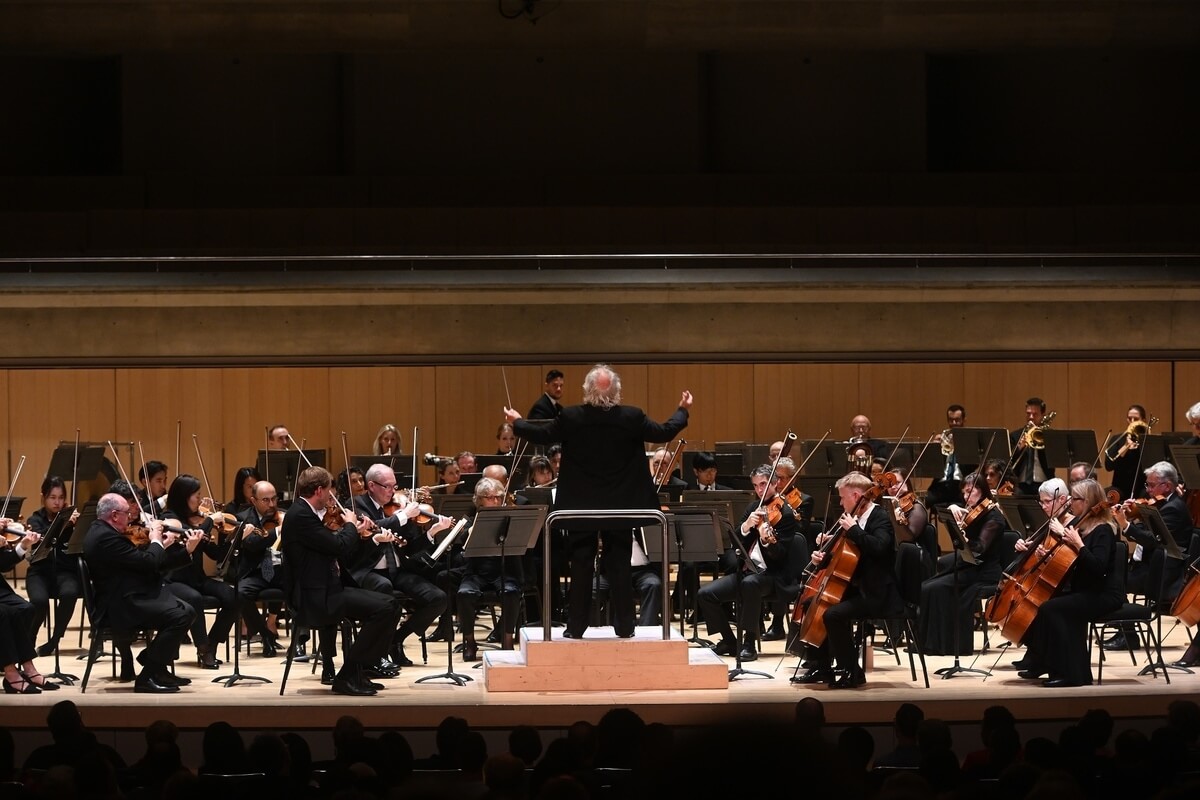The TSO shines under guest conductor Donald Runnicles in a program of Brahms and Strauss, with special note — and a standing ovation — for oboe soloist Sarah Jeffrey.

Brahms: Symphony No. 3; R. Strauss: Concerto in D Major for Oboe and Small Orchestra; R. Strauss: Death and Transfiguration. Donald Runnicles, conductor; Sarah Jeffrey, oboe; Toronto Symphony Orchestra. Roy Thomson Hall, 7:30 p.m., Sept. 27, 2019.
The parade of interesting guest conductors continued last night with Deutsche Oper Berlin maestro Donald Runnicles in town to feed the TSO crowds some intriguing staples of the late Romantic repertoire. Brahms’ Symphony No. 3 and Strauss’s famous early tone poem Tod und Verklärung (Death and Transfiguration) topped the bill, masterworks that reside squarely in Runnicles’ bailiwick.
Yet, tucked away in between these masterworks was a rare gem, the later, classically-informed Strauss Oboe Concerto, given a consummate performance by principal oboist Sarah Jeffrey to a much-deserved, thunderous standing ovation. In many ways, the concert’s second-half work is a rarely heard antipode to the much earlier Death and Transfiguration, and in honesty, it was a remarkable delight to hear, in part for the composer’s late-life reminiscences upon forms long past — a favourite recurrent theme for Strauss — but also its completely relaxed mood, in keeping with a late Strauss opera like Capriccio.
The bucolic opening, sweet-toned, and often in duet with a viola, clarinet or bassoon solo, followed frequently by other orchestral bubblings, proved that the concerto would become the definitive musical highlight of the night. The long phrases provided an early Romantic aesthetic that eminently suited the small chamber orchestra left on stage after the Brahms performance in the first half, and it felt like there was programming continuity.
Even more impressive is the thematic handling throughout in what amounted to being a near concerto grosso. The textures Strauss carefully presents come from a man completely at peace with himself, and in its most polished sense, the Oboe Concerto is an exercise in constructing a meticulously studied masterpiece. The Toronto Symphony Orchestra was faithful to the composer’s intent at every point.
The continuity of all three movements, played without break, made the 25-minute work pass by quickly. One is hardly aware of the work even existing within time itself, but rather ensconced more in a Greco-Roman nostalgia painting, thanks in large part to Runnicles keeping the tempi relaxed and loose while Jeffrey’s translucent tone, particularly in the second movement, evoked a bright sky-blue day’s walk among sunflowers on a late summer afternoon.

The chamber orchestra’s contrapuntal sections were at their most impressive all night in the middle movement’s more Romantic arabesques. I was hoping at one point it wouldn’t end. But most of all, I think I want to hear Sarah Jeffrey play the oboe forever, especially that fun, quirky finale with its perky phrasing and delightful cadenza.
Leading off the concert with the Brahms Symphony was a gutsy move and conventionally, at least at one time, this work would have been the climactic piece for any symphony orchestra concert. Now it is appetizer fare, and perhaps that is how we see a lot of Brahms now, strangely, as opening act for something still more serious.
The work is famous for its F-A♭-F motto theme, an affirmation of his reconciliation with a vow to remain a bachelor all his life so he could write his individually styled works. The motto in German stood for “Frei-Aber-Froh” (Free but Happy) and the first letters of the motto comprised this unique monothematic idea which Brahms suffused into every part of the entire score throughout the first movement.
The orchestra successfully built the three-note theme into the rallying cry of freedom it was intended to be (and presumably a thanksgiving for not marrying Clara Schumann after Robert’s death, and being consigned to raise all their children). The lean sounding, speedy interpretation worked well, but Brahms’ balancing of double forte passages with folksy Ländler motives was best struck by the TSO in the quieter, more intimate textures. Here, the winds were sterling and the brass flawless, and elsewhere too.

The strings could have brought more power and resonance, but in this performance, sticking to Brahms’ Allegro con brio tempo meant a small sacrifice of spectrum in favour of keeping the structure ticking along with not much room to breathe between phrases. And in Brahms, making his complex formal architecture make sense means everything.
This approach worked well in all movements. Runnicles motivated when needed, but stepped back with minimal gestures while the orchestra took the more intimate passages with exquisite aplomb entirely unprompted. The middle movements were interesting, sparkling jewels, more so than the outer movements which occasionally showed slight unevenness between the different orchestral sections.
Regardless, the performance had many high moments, especially in the finale when the upper strings found their power to match the cellos and basses, who were terrific all night. In the best ways possible, the orchestra played Brahms’ efficient masterpiece as a program work, and understood it best from that angle, which I appreciated, given the many times I have heard this symphony interpreted without an appreciation of its many inherent formal possibilities, resulting in an unpleasant disconnect.
The last movement is famous for its elided development and recap blurred purposely to near indistinction by Brahms, so that he can quietly slip in the F-A♭- F theme several more times in the quiescent coda, as if acknowledging his own peaceful resignation that his life had turned out somehow inevitably and beneficially the way it ought to.
And this can only bring us to Strauss’ tone poem Death and Transfiguration, perhaps the ultimate orchestral work about a self-reflective artist’s contemplations, this time at the hour of death, looking back upon a life’s work immersed in idealistic creation, and wondering what, if any, its achievements had come to mean. In seeking the ultimate ideal of Schopenhauerian artistic expression, the artist finds that creative life can only be fulfilled through the experience of dying and being transfigured, a change which realizes every authentic artistic goal suffused with a transcendental sublimity.
Most orchestras glide through the work effortlessly, particularly those last Platonic five minutes when the soul takes flight from the body to find its ideal longings in the eternal cosmos. Death and Transfiguration carries a motto theme as well, reserved mostly for the scenes set in reminiscence and final meditation.
Free-flowing form, more discursive like Liszt’s symphonic poems, yet spiked with turmoil and struggle (such as the gruesome stabbing-death motive), allowed Strauss great freedom of invention and even a degree of haste to project his narrative toward a rare moment of spiritual depiction for the composer, namely the more Wagnerian chords of transcendence within the work’s most famously sublime, final moments.
Orchestras love those last moments. It is a chance to swell with some of the longest phrases in the repertoire written for the concert hall, and seldom do string and brass sections find these moments irresistible.
The TSO put its capstone on a fine evening with a powerful performance that united the concert’s program centred around artistic reflection. In the most articulate of ways, the TSO continues to excel when it offers these themed concerts of intelligent programming and it pays dividends — artistically and at the box office — when we see superb guest conductors like Runnicles pull off these concerts conspicuously well. Audiences no doubt eagerly await his return in February to conduct Bruckner Symphony No. 7 and Wagner’s Siegfried Idyll.
#LUDWIGVAN
Want more updates on classical music and opera news and reviews? Follow us on Facebook, Instagram or Twitter for all the latest.
- SCRUTINY | Opera Atelier’s Film Of Handel’s ‘The Resurrection’ A Stylish And Dramatic Triumph - May 28, 2021
- HOT TAKE | James Ehnes And Stewart Goodyear Set The Virtual Standard For Beethoven 250 - December 15, 2020
- SCRUTINY | Against the Grain’s ‘Messiah/Complex’ Finds A Radical Strength - December 14, 2020



